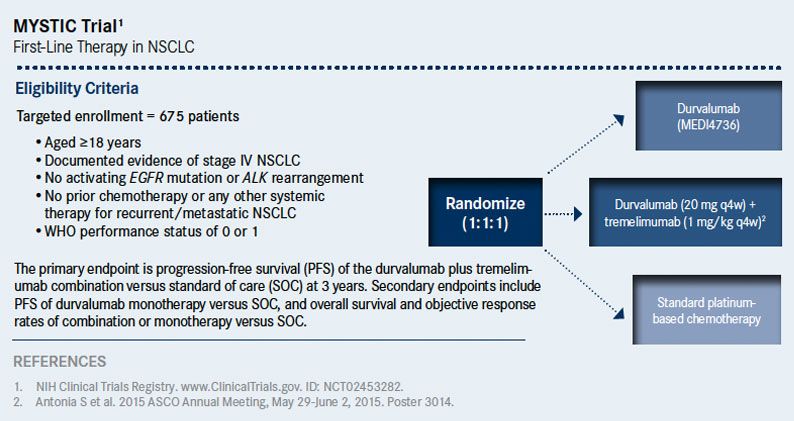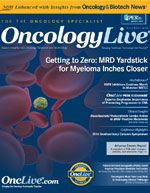Publication
Article
Oncology Live®
Durvalumab/Tremelimumab Combo Explored in Lung Cancer Trial
Author(s):
With the approval of a dual checkpoint blockade treatment in melanoma, researchers hope to have similar success in a phase III trial that combines a PD-L1 inhibitor and CTLA-4 antibody in patients with non–small cell lung cancer.
Naiyer A. Rizvi, MD
With the approval of a dual checkpoint blockade treatment in melanoma, researchers hope to have similar success in a phase III trial that combines a PD-L1 inhibitor and CTLA-4 antibody in patients with non—small cell lung cancer (NSCLC).
“Dual checkpoint blockade has been shown to be more effective in melanoma than single-agent immunotherapy and served as the basis for approval,” Naiyer Rizvi, MD, principal investigator of the MYSTIC study, a randomized, open-label clinical trial investigating durvalumab (MEDI4736) and tremelimumab in NSCLC (NCT02453282), said in an interview with OncologyLive.
The dual blockade approach focuses on two locations in the immune system; durvalumab, a PDL1 inhibitor, targets the tumor microenvironment, and tremelimumab, a CLTA-4 antibody, zeroes in on priming lymph nodes.
Durvalumab has demonstrated single-agent activity in an ongoing phase I/II study involving patients with NSCLC. Treatment has been associated with durable responses. Durvalumab and tremelimumab have nonredundant inhibitory mechanisms and demonstrated synergy in preclinical studies.
Because the agents block distinct processes involved in immunosuppression, the combination might provide greater antitumor activity compared with monotherapy with either agent.
Early trials using this combination in NSCLC resulted in “response rates of about 30%-40%,” said Rizvi, a professor of Medicine and Director of Thoracic Oncology and Immunotherapeutics in the division of Hematology/Oncology at Columbia University Medical Center. He noted that in trials using single-agent immunotherapies, overall response rates were reported in the 15%-20% range. The response rate was lower, however, “in the 10% or less range, in patients who were PD-L1—negative,” said Rizvi. “That represents an unmet need.”
The rationale for the trial is to determine if the combination immunotherapy regimen with dual checkpoint blockade is superior to chemotherapy in the first-line treatment of patients with EGFR and ALK wild-type advanced or metastatic NSCLC.
“We want to determine if the combination results in improved activity and durable benefit in positive and negative subtypes of lung cancer,” said Rizvi. “With chemotherapy, the benefit is for a finite period of time and there are few patients who have durable benefit. Eventually, cancers become resistant to chemotherapy.”
The trial will use 3 treatment arms in a 1:1:1 ratio to determine safety and tolerability. One arm will receive durvalumab, a second arm will receive durvalumab and tremelimumab, and the third arm will receive standard of care (platinum-based chemotherapy). The study was initiated in July 2015 and is expected to be completed by June 2018 with an estimated enrollment of 675 patients. From a researcher standpoint, that finite set of time is attractive, said Rizvi. “The patient receives treatment every 4 weeks, for a total of 12 doses,” he said.

The primary outcome measure is the efficacy of the combination treatment compared with the standard of care in terms of progression-free survival (PFS). Secondary outcome measures include the efficacy of durvalumab monotherapy compared with standard of care in terms of PFS, objective response rate (ORR) of the combination therapy, and the duration of response for the combination therapy. The safety and tolerability profile of the combination therapy will be determined using vital signs, laboratory data, electrocardiograms, and physical examination during the course of the 3-year trial.
Rizvi noted that “another trial, called NEPTUNE (NCT02542293), is looking at overall survival [OS] for this same combination in the first-line setting.”
The primary outcome measure for NEPTUNE is the efficacy of the durvalumab and tremelimumab combination. Secondary endpoints include OS in patients with PD-L1-negative NSCLC, PFS, ORR, and duration of response. To be eligible for this trial, patients should be at least 18 years of age, have documented evidence of stage IV NSCLC, no activating EGFR mutation or ALK rearrangement, and no prior chemotherapy or other systemic therapy for recurrent/metastatic NSCLC.
Results presented at the 2015 ASCO Annual Meeting of an earlier phase 1b study involving this combination in 63 previously treated patients with NSCLC demonstrated an ORR of 27% in PD-L1-negative tumors.1 The disease control rate (response plus stable disease for at least 16 weeks) was 48%. Overall, grade 3/4 toxicity occurred in 41 of 102 evaluable patients, most often colitis, diarrhea, elevated lipase, and elevated liver function tests. However, in the dose combination selected for phase III evaluation (durvalumab 20 mg and tremelimumab 1 mg/kg, each given every 4 weeks), grade 3/4 events occurred in 4 of 22 patients.
To evaluate the safety and tolerability of the combination, investigators enrolled patients with NSCLC who had progressed or relapsed after any line of therapy. The dose escalation/expansion trial evaluated durvalumab at doses of 3 to 20 mg/kg every 4 weeks or 10 mg/kg every 2 weeks, and tremelimumab at doses of 1 to 10 mg/kg every 4 weeks for 6 doses, followed by dosing at 12-week intervals for 12 doses administered for 12 months.
By administering first-line chemotherapy, there is a risk that patients experience fallout, and therefore would not be favorable candidates for second-line immunotherapy, noted Rizvi. “If we can move combination therapy to the first-line setting, it is potentially giving the best therapy upfront, and more patients can experience durable benefit,” he said.
- Antonia S, Goldberg SB, Balmanoukian A, et al. Phase 1b Study of MEDI4736, a programmed cell death ligand-1 (PD-L1) antibody, in combination with tremelimumab, a cytotoxic T-lymphocyte-associated protein-4 (CTLA-4) antibody, in patients with advanced non-small cell lung cancer (NSCLC). J Clin Oncol. 2015; 33(suppl; abstr 3014).









